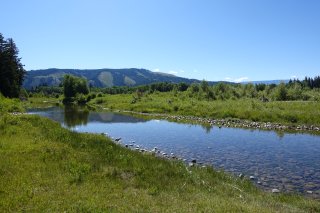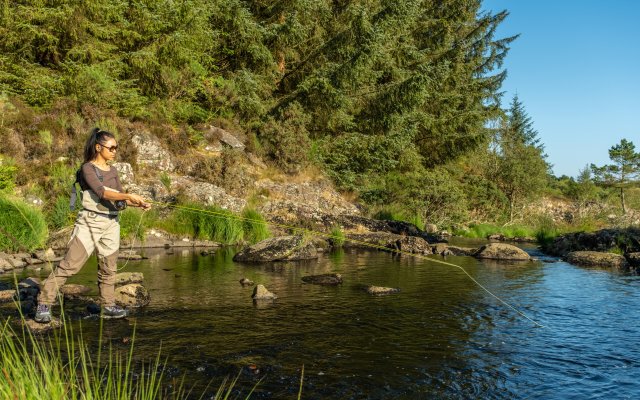Climate Change Connections: Idaho (Trout Fishing)
Climate change is impacting all regions and sectors of the United States. The State and Regional Climate Change Connections resource highlights climate change connections to culturally, ecologically, or economically important features of each state and territory. The content on this page provides an illustrative example. As climate change will affect each state and territory in diverse ways, this resource only describes a small portion of these risks. For more comprehensive information about regional climate impacts, please visit the Fifth National Climate Assessment and Climate Change Impacts by Sector.
On this page:

Introduction: Idaho’s Trout Fishery
Idaho’s vast mountain landscapes and pristine rivers make it an ideal trout fishing destination for anglers. Most of Idaho is part of the Columbia River Basin, a watershed that covers more than 260,000 square miles in the Pacific Northwest.1 As streams flow from the Rocky Mountains into the Columbia River Basin, they swell with snowmelt and branch into a network of tributaries. These feed into larger rivers, eventually flowing into the Columbia River and the Pacific Ocean, creating many thousands of miles of habitat for trout, salmon, and other fish. The state has more than 26,000 miles of streams and over 3,000 natural lakes.2
Idaho’s cold-water streams make for some of the best trout fishing in the country. Trout species found in these waters include native cutthroat trout and bull trout as well as non-native brook and rainbow trout.3,4 Native trout are important parts of their ecosystems and good indicators of stream health because they require clean, cold water. Trout also play a key role in Idaho’s recreational fishing industry, which in turn provides jobs, conservation funding, and opportunities for thousands of people to connect with the outdoors.

Climate Impacts: High Temperatures and Low Flows Threaten Trout
In response to increased concentrations of heat-trapping greenhouse gases in Earth’s atmosphere, average temperatures at the Earth’s surface are increasing and are expected to continue rising.5 Since the start of the 20th century, Idaho has warmed about 2°F.6 Scientists project that the state will warm at least the same amount over the next century and significantly more with higher greenhouse gas concentrations.6 Idaho’s rapidly flowing rivers are ideal for trout, which do best in cold, clear, highly oxygenated water and are sensitive to optimal water temperature at different growth stages.7 As climate change brings warmer temperatures, Idaho’s cold-water streams are becoming less hospitable for native fish species like cutthroat and bull trout.
Projections show that if Idaho’s streams warm 3.6°F, which could happen by the end of the century or sooner if warming rates accelerate, cutthroat trout could lose more than 11 percent of their habitat and bull trout could lose about 46 percent of their habitat.8, 9 Warming water is expected to expand warm-water habitat, which can benefit competitors like smallmouth bass, which prey on juvenile trout.8, 10
In a warming climate, more precipitation will be expected to fall as rain rather than snow in most areas, reducing the extent and depth of snowpack. With warmer winters and springs, the seasonality of snowpack is also changing. Higher temperatures cause snow to melt earlier, which in turn affects the timing and availability of water. Mountain snowpack plays a key role in the water cycle in western North America, storing water in the winter when snow falls and releasing it as runoff in spring and summer when the snow melts. Changes in mountain snowpack can affect agriculture, winter recreation, and tourism, as well as plants and wildlife. For example, fish spawning could be disrupted if changes in snowpack or snowmelt alter the timing and abundance of streamflows.
Changing precipitation patterns can also cause flooding and drought that harm trout habitat. Extreme precipitation could cause sporadic flooding, which could wipe out juvenile trout and eggs.10 Trout migrate upstream to colder headwaters to spawn, with cutthroat trout spawning in spring, and then back downstream in the fall, sometimes traveling more than 60 miles.11 Low stream flow and barriers such as dams can trap trout in warmer basins and prevent them from moving upstream. Additionally, floods could wash out valuable shade and cover and erode surrounding banks, filling rivers with sediment and smothering the gravel streambeds that trout need to spawn.12 Dry winters and warm water lead to higher fish mortality which can create poor fishing conditions, with anglers catching fewer trout overall.13 Continued changes to Idaho’s trout fisheries could further impact local ecosystems and economies.
Taking Action: Protecting Habitat in a Changing Climate
Addressing climate change requires reducing greenhouse gas emissions while preparing for and protecting against current and future climate impacts. Communities, public officials, and individuals in every part of the United States can continue to explore and implement climate adaptation and mitigation measures. In Idaho, conservationists and anglers are taking steps to respond to help protect trout and their habitats in a changing climate, including:

- River conservation and restoration. Idaho Fish and Game has partnered with ranchers, landowners, and conservation organizations to restore stream habitat and support native trout populations.14 For example, on the Upper Blackfoot River, a multiyear effort has reduced erosion and created cold, deep pools and cover for trout.15 Idaho Fish and Game is also removing dams, culverts, and other barriers to migration so that trout can reach headwaters to spawn. In the spring and fall, when lower river basins are still relatively cool, trout forage in these areas to gain energy for upstream migration. Rivers across the state can benefit from conservation and habitat restoration projects. Taxes from purchases of angler licenses and fishing equipment also fund restoration projects through the Sport Fish Restoration Program.16
- Invasive species management. In addition to surveying existing populations and managing fishery regulations to prevent overfishing of vulnerable species, reducing the impact of non-native fish can help protect trout populations.17 Anglers can play an active role in helping native trout populations by removing non-native species. In certain select waters, Idaho Fish and Game offers monetary incentives for anglers who catch and remove non-native fish, such as walleye and lake trout, which would prey on or outcompete with native cutthroat and bull trout.18
To learn more about climate change impacts in Idaho and the Northwest region, see Chapter 27 of the Fifth National Climate Assessment.
Related Resources
- EPA Climate Change Indicators: Streamflow
- EPA Climate Change Indicators: Drought
- EPA Climate Change Indicators: Heavy Precipitation
- EPA Climate Change Indicators: Snowpack
- EPA Climate Change Indicators: Tribal Connection: Trends in Stream Temperatures in Snake River
- Idaho State Climate Summary 2022 (NOAA)
- Fifth National Climate Assessment: Chapter 8: Ecosystems, Ecosystem Services, and Biodiversity
- Idaho Climate-Economy Impacts Assessment: Recreation and Tourism (University of Idaho)
References
1 EPA. (n.d.). About EPA’s work in the Columbia River Basin. Columbia River. Retrieved July 12, 2023, from https://www.epa.gov/columbiariver/about-epas-work-columbia-river-basin
2 Idaho Department of Fish and Game. (n.d.). Fishing. https://idfg.idaho.gov/fish
3 Idaho Department of Fish and Game. (2023). Idaho fishing: 2022–2024 seasons & rules. https://idfg.idaho.gov/sites/default/files/seasons-rules-fish-2022-2024.pdf
4 U.S. Department of Agriculture, Forest Service. (n.d.). Fish. Northern Region. Retrieved July 12, 2023, from https://www.fs.usda.gov/detail/r1/plants-animals/fish/?cid=stelprdb5131000
5 EPA. (2024). Climate change indicators: U.S. and global temperature. Retrieved July 25, 2024, from https://www.epa.gov/climate-indicators/climate-change-indicators-us-and-global-temperature
6 Runkle, J., Kunkel, K. E., Frankson, R., Champion, S. M., Stevens, L. E., & Abatzoglou, J. T. (2022). Idaho state climate summary 2022 (NOAA Technical Report NESDIS 150-ID). NOAA National Environmental Satellite, Data, and Information Service. https://statesummaries.ncics.org/chapter/id/
7 EPA. (2001). Scientific issues relating to temperature criteria for salmon, trout, and char native to the Pacific Northwest (Technical Synthesis EPA 910-R-01-007). https://nepis.epa.gov/Exe/ZyPDF.cgi/P1004J0T.PDF?Dockey=P1004J0T.PDF
8 Caudill, C., Masingale, J., Seaborn, T., Hora, D., & Isaak, D. (2021). Sensitivity of Idaho fishes to climate change (Idaho Climate-Economy Impacts Assessment). James A. & Louise McClure Center for Public Policy Research, University of Idaho. https://www.uidaho.edu/-/media/UIdaho-Responsive/Files/president/direct-reports/mcclure-center/iceia/iceia-fish-report-2021.pdf
9 Jenkins, A. R., & Keeley, E. R. (2010). Bioenergetic assessment of habitat quality for stream-dwelling cutthroat trout (Oncorhynchus clarkii bouvieri) with implications for climate change and nutrient supplementation. Canadian Journal of Fisheries and Aquatic Sciences, 67(2), 371–385. https://doi.org/10.1139/F09-193
10 Chang, M., Erikson, L., Araújo, K., Asinas, E. N., Chisholm Hatfield, S., Crozier, L. G., Fleishman, E., Greene, C. S., Grossman, E. E., Luce, C., Paudel, J., Rajagopalan, K., Rasmussen, E., Raymond, C., Reyes, J. J., & Shandas, V. (2023). Ch. 27. Northwest. In A. R. Crimmins, C. W. Avery, D. R. Easterling, K. E. Kunkel, B. C. Stewart, & T. K. Maycock (Eds.), Fifth National Climate Assessment. U.S. Global Change Research Program. https://doi.org/10.7930/NCA5.2023.CH27
11 U.S. Department of Agriculture, Forest Service. (1995). Conservation assessment for inland cutthroat trout (General Technical Report RM-GTR-256). http://www.nativefishlab.net/library/textpdf/11502.pdf#page=7
12 Scheurer, K., Alewell, C., Bänninger, D., & Burkhardt-Holm, P. (2009). Climate and land-use changes affecting river sediment and brown trout in alpine countries—a review. Environmental Science and Pollution Research, 16(2), 232–242. https://doi.org/10.1007/s11356-008-0075-3
13 Meyer, K. A., McCormick, J. L., Kozfkay, J. R., & Dillon, J. C. (2023). Effects of elevated water temperature on cutthroat trout angler catch rates and catch‐and‐release mortality in Idaho streams. Fisheries Management and Ecology, 30(2), 134–141. https://doi.org/10.1111/fme.12605
14 Idaho Department of Fish and Game. (2019). Fisheries Management Plan 2019 – 2024. https://idfg.idaho.gov/sites/default/files/2019-2024-idaho-fisheries-management-plan-original.pdf?update10-2019
15 Idaho Department of Fish and Game. (2021, April 20). Idaho Fish and Game leads restoration of the upper Blackfoot River. Retrieved July 12, 2023, from https://idfg.idaho.gov/press/idaho-fish-and-game-leads-effort-restore-upper-blackfoot-river-fish-and-wildlife
16 U.S. Fish and Wildlife Service. (n.d.). Sport fish restoration. Retrieved July 12, 2023, from https://www.fws.gov/program/sport-fish-restoration
17 Idaho Department of Fish and Game. (2022). Management plan for the conservation of Bonneville cutthroat trout in Idaho. https://idfg.idaho.gov/sites/default/files/planboncutthroat22.pdf
18 Idaho Department of Fish and Game. (n.d.). Angler incentive programs. Retrieved July 12, 2023, from https://idfg.idaho.gov/fish/incentive

